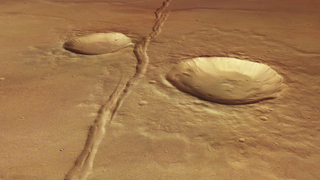Mars Express orbiter takes a deep dive into ancient Red Planet lake (images)
"We believe that water, and a lot of it, once existed here."

A Mars orbiter has just taken a "deep dive" into an ancient Martian lake, figuratively, at least.
Larger than any lake currently on Earth, the dried-up remnants of this ancient lakebed were just captured in incredible detail by the European Space Agency (ESA) Mars Express spacecraft, which has been orbiting the Red Planet since 2003.
"This patch of Mars — shown in a new view from Mars Express's High-Resolution Stereo Camera (HRSC) — is known as Caralis Chaos," ESA scientists wrote in a statement. "We believe that water, and a lot of it, once existed here."
In the Caralis Chaos region lie several now-empty basins that form the remnants of Lake Eridania, an ancient lake that had an area of roughly 424,712 square miles (1.1 million square kilometers) — about the size of Egypt!
ESA scientists believe the lake likely existed around 3.7 billion years ago and contained enough water to fill the Caspian Sea three times over.
Related: Possible signs of Mars life: Astrobiologist explains Perseverance rover's exciting find
Lake Eridania eventually began to dry out, transitioning from a gargantuan body of water to a series of smaller lakes before disappearing completely alongside much of the rest of the water on Mars.
Get the Space.com Newsletter
Breaking space news, the latest updates on rocket launches, skywatching events and more!
Unlike Earth, Mars does not possess a natural magnetic field. Without this magnetic "bubble" to protect the Red Planet against the solar wind, which consists of high-energy charged particles that stream from the sun, Mars' atmosphere was eroded away. This led to the evaporation of its liquid water and then this water vapor leaking from the atmosphere to space.
The ancient lakebed is now dry and filled with raised mounds formed by winds that swept dust across the planet.
"This dust was later covered and altered by water before drying out again and breaking apart," stated the ESA team.

The Mars Express images also showcase two long cracks that run through the region, cutting through the ancient lakebed. These are known as the Sirenum Fossae faults and are evidence of volcanic activity in the region.
They were formed as the Tharsis region of Mars, which hosts the solar system's largest volcanoes, developed, putting incredible stress on Mars's crust—the evidence of which can be seen here.
"Volcanic stress is also to blame for the many wrinkle ridges found here," continued the ESA team. "These appear as wriggly lines weaving across the frame horizontally. Wrinkle ridges are common on volcanic plains, forming as new lava sheets are compressed while still soft and elastic, causing them to buckle and deform."
More evidence of water can also be found in the region's impact craters, which formed when objects from space collided with the Martian surface.
The large central crater shows evidence of material flowing away from the site of impact. The ESA team believes this may indicate that water existed in this area even after Lake Eridania disappeared.
Join our Space Forums to keep talking space on the latest missions, night sky and more! And if you have a news tip, correction or comment, let us know at: community@space.com.

A chemist turned science writer, Victoria Corless completed her Ph.D. in organic synthesis at the University of Toronto and, ever the cliché, realized lab work was not something she wanted to do for the rest of her days. After dabbling in science writing and a brief stint as a medical writer, Victoria joined Wiley’s Advanced Science News where she works as an editor and writer. On the side, she freelances for various outlets, including Research2Reality and Chemistry World.
-
ZZTOP Reply
Mars is about half the size of the Earth, the largest body of water on Earth is the Pacific ocean, so if Caralis Chaos was bigger than the Pacific ocean then Mars was clearly a water planet. I have never heard this beforeAdmin said:The Mars Express spacecraft has taken a "deep dive" into Caralis Chaos, an ancient lake on the Red Planet believed to have been larger than any body of water on Earth.
Mars Express orbiter takes a deep dive into ancient Red Planet lake (images) : Read more